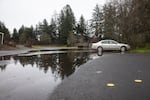
Chelsea DeVos scrambles to salvage possessions from her home as the Santiam Fire approaches near Gates, Ore., Sept. 9, 2020.
Bradley W. Parks / OPB
Oregon last week released its fifth biennial climate assessment, which illustrates the past, present and future implications of climate change on the state and its people.
As you may have surmised, the outlook is dim.
“A lot of what we report on here is consistent with what has been understood and expected for a decade or, in some cases, several decades,” said Erica Fleishman, director of the Oregon Climate Change Research Institute, which assembles the report, and a professor at Oregon State University.
Scientific consensus is that burning coal, petroleum and other fossil fuels emits heat-trapping carbon, causing the planet to warm nearly beyond repair.
Temperatures are going up year-round. Precipitation is surging in the winter, and more of it is falling as rain than as snow. Wildfires are getting bigger and happening more often. And all of those things have the effect of deepening and proliferating racial and economic disparities already present in our society.
“It becomes more and more crystal clear that climate change is not just affecting polar bears on some distant iceberg,” said Emily York, who leads Oregon’s Climate and Health Program. “It’s affecting people, and it’s affecting our communities’ and our children’s health.”
Fleishman said that while climate change has very much entered the chat in Oregon, the state has opportunities before it to blunt the onslaught.
“Because Oregon still has it pretty good compared to a lot of parts of the country and the world,” she said.
Here’s a snapshot of climate change and its effects on Oregon, by the numbers:
Wildfires in Oregon will be larger and more frequent.
Last summer’s wildfires were historically devastating. The fires killed several Oregonians and displaced thousands, many long-term if not permanently.
Almost all recent modeling indicates more of Oregon will burn in the coming years. Some projections show a 200% increase in burned area annually by mid-century.
Related: Climate change set the conditions for Oregon wildfires, but did it stoke the flames too?
The largest wildfires, which the climate assessment defines as those scorching more than 12,350 acres, will also increase.
“Although there is a projection that the size of fires will increase in Oregon, it’s difficult to say whether that will translate into very costly and very disruptive losses for tens of thousands of Oregonians,” Fleishman said.
Oregon isn’t becoming California, where Santa Ana and Diablo winds regularly create hot, dry and crunchy fire conditions. Major wind events like the one that fanned last year’s firestorm are rare for Oregon.
It’s getting hot in here, especially during summer.
The state’s average annual temperature is projected to increase 5 degrees Fahrenheit by 2050 and more than 6 degrees in summer.
Southwest Oregon is truly feeling the burn. Medford sees about 21 more days a year exceeding 90 degrees than it did in 1940. Portland and Pendleton both have about eight more hot days a year.
Extreme heat is a public health risk that disproportionately affects marginalized communities.

Children play in the splash zone at Director Park in downtown Portland.
Bradley W. Parks / OPB
About one in every three single-family homes in Oregon does not have air conditioning. Three in every four multigenerational homes are also without cooling systems.
“We have the data that shows that when we have these extreme heat events, we have a spike in those seeking help in emergency department rooms across Oregon,” York said.
Oregon will likely see more precipitation. Less of it will be snow.
Precipitation levels change from year to year, but statewide Oregon will likely see a gradual increase over the coming decades, according to the report.
More than one-third of Oregon experienced at least moderate drought from 2000 to 2020, on average, but more precipitation will not translate to less drought necessarily.
As temperatures climb, precipitation is less likely to fall as snow. For example, about half of wet days in the Cascades have snow, which has been the case since the latter stages of the 20th century. By the middle of this century, less than 25% of wet days in the mountain range will have snow.
Snowpack is also expected to decline in the coming decades — by at least 60% statewide by 2050. While snowpack has been historically very difficult to measure, Oregon’s outlook is becoming clearer with advances in climate science.

An aerial image made with a drone shows the Upper Deschutes River near Bull Bend outside La Pine, Ore.
Brandon Swanson / OPB
Diminishing snowpack could lead to water shortages, drought and increased wildfire risk.
“Those changes in the snowpack are likely to have pretty strong ramifications for a lot of the economic and social structures in the state,” Fleishman said.
Add to that list drinking water supplies, irrigation, river and stream health, glacial health, and winter recreation.
Sea levels are rising on the Oregon Coast, but so is the coastline.
Rising sea levels pose a threat to coastal communities across the globe, contributing to flooding, erosion and destruction. As the planet warms, glaciers and ice sheets melt, water in the oceans increases and expands.
We’ve known this for a while, and the latest climate science confirms that sea level rise will continue and at faster rates should humans not kick their greenhouse gas habit.
“Coastal communities along the Oregon Coast should expect that issues associated with various coastal hazards of erosion and flooding will get worse,” said Peter Ruggiero, a professor of coastal geomorphology at Oregon State and co-author of the climate assessment’s coastal hazards chapter.
Projected sea level rise varies along the Oregon Coast. The climate assessment pulled three coastal cities for comparison. If we significantly cut emissions, sea levels are projected to rise 0.1 feet in Astoria by 2050, 0.4 feet in Charleston and 0.6 feet in Newport.
On the other end of the spectrum, if emissions continue at current levels or even increase, sea level rise could reach 2.4, 2.7 and 2.9 feet for Astoria, Charleston and Newport, respectively.

A car sits surrounded by saltwater at the boat ramp in Nehalem, Ore. King tides can help mimic the effects of sea level rise on the coast.
Erin Ross / OPB
While sea levels are rising along the Oregon Coast, so too is the coastline itself due to tectonic shifts and other factors. A large portion of the coastline, too, is undeveloped. In that regard, Oregon is generally better positioned to handle sea level rise than, say, southern Florida, where water could inundate low-lying communities.
However, rising, warming oceans still pose a threat to Oregon’s rocky coast, especially combined with changes to the wave climate and storm patterns. Not to mention the Big One, a calamitous magnitude-9.0 earthquake predicted to hit off the Northwest coast in the coming decades.
“If we are thinking about ways of managing for sea level rise, we might also be doing ourselves a favor in terms of managing for reducing the potential negative impact of the Cascadia Subduction Zone earthquake and tsunami,” Ruggiero said.
